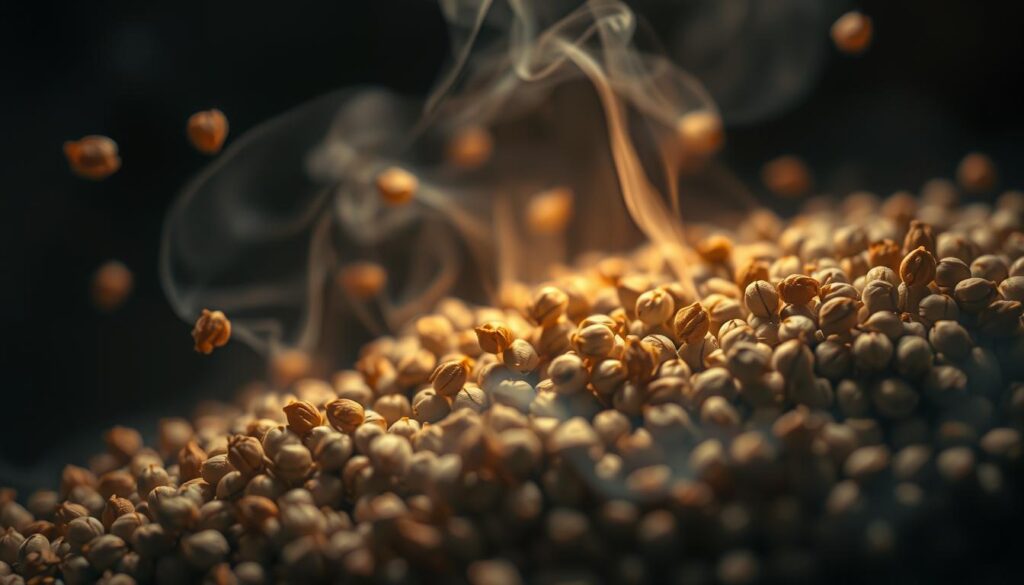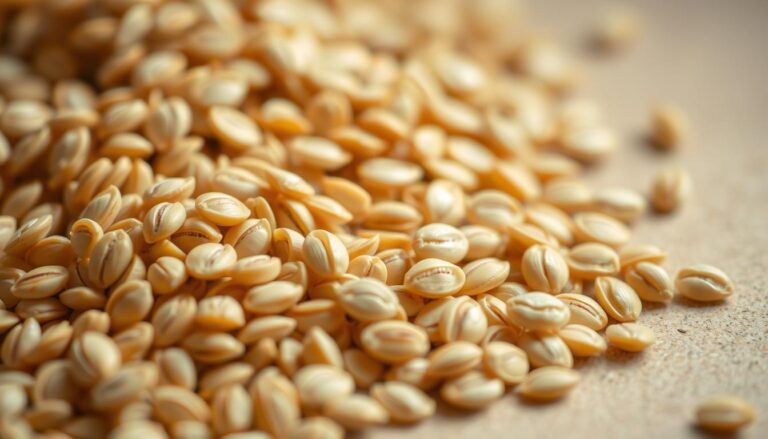These tiny seeds carry a remarkable caraway seeds taste. It dances between earthy, licorice-like notes and a subtle peppery undertone.
The flavor profile of caraway seeds is truly extraordinary. Imagine a spice that can remind you of anise, with a hint of citrus and a gentle warmth. Chefs and home cooks alike treasure these seeds for their ability to elevate both savory and sweet recipes.
Originating from the carrot family, caraway seeds have been a staple in kitchens across Europe for centuries. Their complex taste isn’t just about flavor—it’s about connecting with a rich culinary tradition that spans generations and cultures.
Key Takeaways
- Caraway seeds offer a unique flavor combining earthy and licorice-like notes
- They are versatile and used in both savory and sweet dishes
- Originate from the carrot family with a long culinary history
- Provide a distinctive taste that enhances various recipes
- Used extensively in European cuisine
Table of Contents
Introduction to Caraway Seeds
Caraway seeds are a culinary treasure with a long history. They have been used for thousands of years in cooking around the world. Exploring caraway seeds reveals a world of strong flavors and aromas.
Known scientifically as Carum carvi, these seeds come from Western Asia, Europe, and North Africa. Their unique taste and versatility make them a favorite in many recipes.
What Are Caraway Seeds?
Caraway seeds are the dried fruit of the caraway plant. They have a complex flavor that includes:
- Slightly sweet undertones
- Sharp, peppery notes
- Subtle hints of anise
Historical Significance
Caraway seeds have been valued for at least 8,000 years. Ancient Egyptians used them for cooking and medicine. In Central and Eastern Europe, they’re key in making dishes like rye bread and sauerkraut.
Culinary Uses
Exploring caraway seeds opens up new culinary possibilities. They’re especially loved in:
- Bread making
- Seasoning meat dishes
- Flavoring soups and stews
- Creating traditional liquors like Kümmel
Their unique flavor adds depth to both savory and sweet dishes. This makes them a versatile ingredient in your kitchen.
Nutritional Profile of Caraway Seeds
Caraway seeds are a nutritional powerhouse. They are packed with essential nutrients that can boost your health. These tiny seeds offer vitamins, minerals, and beneficial compounds that make them valuable in your diet.
Exploring the health benefits of caraway seeds shows an impressive nutritional profile. This profile supports your overall wellness. Let’s look at the key nutrients that make these seeds remarkable.
Vitamins and Minerals
Caraway seeds are rich in nutrients that help your body function well. Here’s a breakdown of their impressive mineral content:
- Calcium: 689 mg per 100g (69% of daily recommended intake)
- Iron: 16.23 mg per 100g (90% of daily recommended intake for men)
- Magnesium: 258 mg per 100g (65% of daily recommended intake)
- Potassium: 1351 mg per 100g (29% of daily recommended intake)
Health Benefits of Caraway Seeds
The benefits of caraway seeds go beyond their nutritional value. These seeds offer health advantages that support your well-being:
- Digestive health support
- Natural antimicrobial properties
- Potential metabolism boost
- Appetite regulation
Caloric Value
Knowing the caloric content of caraway seeds helps you add them to a balanced diet. Here’s a detailed nutritional breakdown:
| Nutrient | Amount per 100g |
|---|---|
| Calories | 333 kcal |
| Protein | 19.77 g |
| Fat | 14.59 g |
| Carbohydrates | 49.90 g |
| Dietary Fiber | 38 g |
Caraway seeds have an impressive 38% dietary fiber content. They are an excellent addition to your diet. Their unique combination of nutrients makes them a flavorful spice and a true nutritional supplement that supports your health.
Caraway Seeds in Cooking
Caraway seeds are a culinary treasure that can transform your cooking with their unique flavor profile. Dating back to 3000 BC, these ancient spices have been enhancing dishes for thousands of years, particularly in European cuisines.
When exploring how to use caraway seeds in the kitchen, you’ll discover their remarkable versatility. Their distinctive taste combines earthy, slightly anise-like notes that work beautifully in both savory and sweet recipes.
Flavor Profile
Caraway seeds offer a complex flavor that can be described as:
- Slightly sharp and peppery
- Reminiscent of fennel and anise
- Warm and aromatic
- Nutty with a hint of citrus
Common Dishes Featuring Caraway
Discover popular caraway seeds recipes across different cuisines:
| Cuisine | Typical Dishes |
|---|---|
| German | Rye bread, sauerkraut |
| Hungarian | Goulash, potato dishes |
| Scandinavian | Aquavit liqueur, bread |
Tips for Cooking with Caraway
To maximize flavor when using caraway seeds in the kitchen, try these techniques:
- Toast seeds briefly to enhance their aromatic qualities
- Grind seeds for more intense flavor distribution
- Use sparingly, as their taste can be quite strong
- Pair with root vegetables, meats, and bread recipes
Pro tip: Caraway seeds work wonderfully in spice blends, adding depth to your culinary creations.
How Caraway Seeds Are Cultivated
Caraway seeds are a fascinating agricultural treasure. They connect farmers with food lovers all over the world. The journey of these aromatic seeds from field to kitchen is quite intricate.
When looking to buy caraway seeds, knowing their origin is key. Caraway is a biennial plant from the Apiaceae family. It grows mainly in Europe, North Africa, and parts of Asia.
Optimal Growing Conditions
Caraway needs specific conditions to grow well:
- Temperate climate with moderate temperatures
- Well-drained, fertile soil with pH between 6.0-7.0
- Full sun exposure
- Adequate moisture without waterlogging
Harvesting Process
Harvesting caraway seeds is a precise process. Farmers collect them in late summer when the fruits are mature. Timing is crucial to ensure optimal flavor and essential oil content.
When searching for where to buy caraway seeds, look for sources that understand these cultivation nuances. High-quality caraway seeds are typically harvested when they reach a dark brown color with a distinctive crescent shape.
Interestingly, caraway grown in northern latitudes tends to produce higher volatile oil quantities compared to warmer regions. This geographical factor significantly influences the seeds’ flavor profile and culinary value.
Caraway Seeds vs. Other Spices
Exploring spices shows us how different similar-looking seeds can be. Caraway seeds have a unique taste that makes them stand out. They offer a special flavor that’s hard to find elsewhere.
Many spices might look the same at first, but caraway seeds are different. They add a unique touch to dishes that’s hard to match.
Comparing Caraway and Cumin
Cumin and caraway seeds might look similar, but they taste very different. Here’s a quick look at their main differences:
- Cumin has a warm, nutty, slightly smoky taste
- Caraway has a sharper, bittersweet flavor with anise-like notes
- Cumin is popular in North African, Middle Eastern, and Mexican dishes
- Caraway is mainly used in European cooking
Caraway vs. Fennel Seeds
Caraway seeds and fennel seeds have a similar hint of licorice, but they taste different. Caraway’s flavor is stronger and more complex. It’s a key ingredient in many traditional recipes.
| Characteristic | Caraway Seeds | Fennel Seeds |
|---|---|---|
| Flavor Intensity | Sharp and bittersweet | Milder, sweeter |
| Culinary Origin | European cuisine | Mediterranean regions |
| Common Uses | Rye bread, sausages, liquors | Italian and Indian dishes |
Knowing these differences helps you pick the right spice for your recipes. Each seed adds its own special flavor to dishes, making them better.
Medicinal Properties of Caraway
Caraway seeds have been valued for centuries for their health benefits. These tiny seeds are packed with power for your overall wellness. They’ve been recognized since around 1500 B.C. for their medicinal properties, especially in digestive health.

Caraway seeds offer more than just flavor. They are rich in essential nutrients, providing several health benefits:
- Powerful digestive support
- Natural antioxidant properties
- Potential relief from stomach discomfort
- Traditional remedy for bloating
Digestive Benefits
Caraway seeds are a natural digestive aid. They can help reduce stomach cramps and increase appetite. Traditional herbal medicine uses caraway to manage indigestion and promote digestive health. The essential oils in caraway, like carvone and limonene, soothe the stomach.
“Caraway has been a trusted digestive remedy since ancient times, supporting gut health naturally.” – Traditional Herbal Medicine Experts
Antioxidant Effects
Caraway seeds also have strong antioxidant properties. They contain compounds that protect your body from oxidative stress. With high levels of calcium, iron, and dietary fiber, caraway seeds boost your immune system and overall health.
Scientific research is still exploring caraway seeds’ health benefits. They support digestive function and offer antioxidant protection. These small seeds have been a natural wellness solution for thousands of years.
Storing Caraway Seeds
Proper storage is key when using caraway seeds in cooking. These seeds can lose their flavor if not stored right. Knowing how to store them well keeps their taste and extends their life.
- Choose an airtight container with a tight-fitting lid
- Store in a cool, dark place away from direct sunlight
- Avoid humid areas like near the stove or dishwasher
- Keep seeds in a pantry or kitchen cabinet
Optimal Storage Conditions
The best place for caraway seeds is a cool, dark spot. Glass jars with secure lids are great for keeping their flavor. Ceramic or metal containers also work well.
Shelf Life Considerations
Caraway seeds stay fresh for 6-12 months if stored right. Check for these signs of freshness:
- Vibrant, rich color
- Strong, characteristic aroma
- No signs of moisture or clumping
- No musty or off-putting smell
By following these storage tips, your caraway seeds will stay flavorful. They’ll be ready to add a unique taste to your dishes whenever you cook.
Caraway Seeds in Different Cuisines
Caraway seeds are found in many cuisines around the world. They add unique flavors to dishes from Europe to the Middle East. These small seeds are shaped like crescents and are very versatile.
Caraway seeds are a big deal in European cooking. They have a rich, aromatic taste that’s loved in many traditional dishes.
European Culinary Traditions
In Europe, caraway seeds are key in many famous dishes. They’re especially popular in German, Scandinavian, and Hungarian cooking.
- German Schweinebraten: A classic pork roast infused with caraway
- Rye bread featuring whole caraway seeds
- Traditional sauerkraut preparations
- Hungarian pastries and baked goods
Middle Eastern Flavor Profiles
In Middle Eastern cooking, caraway seeds are used in a more subtle way. They add depth to dishes, even when cumin is the main flavor.
In Indian cuisine, caraway seeds are a bit of a surprise. Chefs use them to add a special flavor to spice blends and regional dishes.
The subtle, licorice-like undertone of caraway seeds can transform ordinary recipes into extraordinary culinary experiences.
Caraway seeds are great for adding flavor to European comfort foods or Middle Eastern dishes. They make cooking exciting and versatile.
Fun Facts About Caraway Seeds
Caraway seeds are more than just a spice. They have a rich history and cultural significance. Their stories are filled with myths and unexpected uses.

Magical Myths and Ancient Folklore
In European folklore, caraway seeds were seen as magical. People believed they could protect against bad energy and theft. They thought:
- Carrying caraway seeds could prevent theft
- Hunters believed they brought good luck
- Lovers exchanged caraway gifts to show love
Unique Uses Beyond the Kitchen
Caraway seeds are not just for cooking. They have many other uses. Their taste is used in:
- Traditional Medicine: For digestive issues
- Aromatherapy: For relaxation
- Perfumery: In unique fragrances
“Caraway seeds are not just a spice, but a cultural artifact carrying centuries of human experience.” – Culinary Historian
Surprising Cultural Connections
Different cultures have special bonds with caraway seeds. In some, they’re more than food – they’re symbols of connection and heritage.
| Culture | Caraway Significance |
|---|---|
| German | Used in traditional bread and meat dishes |
| Eastern European | Symbolic in wedding ceremonies |
| Middle Eastern | Utilized in herbal medicine practices |
When you see caraway seeds, think of their more than flavor significance. They bring a world of culture and history.
Caraway Oil and Its Uses
Caraway seeds are more than just a spice. The oil from these seeds is a natural remedy with many uses. Learning about how it’s made and its benefits can open up new ways to use this ancient plant.
Extraction Process
Caraway oil is made by steaming dried seeds. This careful method keeps the oil’s healing properties strong. Here’s how it’s done:
- Harvesting mature caraway seeds
- Drying the seeds completely
- Using high-temperature steam to release essential oils
- Condensing and collecting the pure essential oil
Aromatherapy Benefits
The essential oil from caraway seeds has many benefits. Studies show it can help with digestion and mood. For example, a study found that 63.2% of people felt pain relief with caraway and peppermint oil.
“Caraway oil represents a natural approach to holistic healing, connecting ancient wisdom with modern scientific understanding.”
Caraway oil can help in many ways, including:
- Stress reduction
- Digestive system support
- Mood enhancement
- Relaxation promotion
Always talk to a doctor before using caraway oil. Some people might be sensitive to it. It’s important to test it first.
Recipe Ideas Featuring Caraway Seeds
Exploring caraway seeds recipes can transform your home cooking. It adds depth and unique flavor to both bread and savory dishes. Cooking with caraway seeds is a delightful way to enhance your culinary repertoire. It brings traditional European flavors to your kitchen.
Rustic Rye Bread with Caraway
Create a classic rye bread that showcases the distinctive taste of caraway seeds. Here’s a simple recipe to get you started:
- Ingredients:
- 2 1/3 cups all-purpose flour
- 1-2 tablespoons caraway seeds
- 2 1/4 teaspoons instant yeast
- 1 cup water
- Baking instructions:
- Rising time: 60-90 minutes
- Baking temperature: 350°F
- Baking duration: 35-50 minutes
- Internal bread temperature: 205-210°F
Hearty Irish Pork Stew with Caraway
Elevate your stew game with the aromatic touch of caraway seeds. This recipe brings warmth and complexity to your meal:
| Ingredient | Quantity |
|---|---|
| Bone-in pork shoulder | 3.5-4 pounds |
| Caraway seeds | 1 tablespoon |
| Irish stout | 1.5 cups |
| Cooking time | 3 hours 15 minutes |
Pro tip: When cooking with caraway seeds, start with a small amount and adjust to taste. The seeds have a strong, distinctive flavor that can transform your dishes from ordinary to extraordinary.
Comforting Caraway Soup with Semolina Dumplings
A traditional European soup that highlights the versatility of caraway seeds:
- Broth preparation:
- Vegetable or chicken broth: 1.5 liters
- Caraway seeds: 2-3 tablespoons
- Infusion time: 25 minutes
- Semolina dumplings:
- Semolina: 1/2 cup
- Broth: 2 cups
- Dumpling thickness: 1-1.5 cm
Whether you’re baking bread, preparing a stew, or crafting a comforting soup, caraway seeds recipes offer a world of culinary exploration. Start experimenting and discover the magic of this remarkable spice!
Conclusion: The Versatility of Caraway Seeds
Caraway seeds take you on a unique culinary journey. They add a special flavor and nutrition to your dishes. From German rye bread to European classics, they show their versatility in the kitchen.
Caraway seeds are more than just a flavor enhancer. They are packed with minerals like iron, calcium, and magnesium. These seeds help with digestion, reduce inflammation, and boost your immune system. They’re great for anyone looking to improve their health naturally.
Adding caraway seeds to your cooking can change your culinary adventures. Try them in baking, as a garnish, or in traditional recipes. They’re gluten-free, vegan, and vegetarian, making them a great choice for everyone. Discover the cultural heritage and health benefits of this amazing spice.
FAQ
What exactly are caraway seeds?
Caraway seeds come from the Carum carvi plant, part of the parsley family. They are crescent-shaped, brown, and have a unique taste. This taste is a mix of nutty, earthy, and slightly anise-like. They’re used in European and Middle Eastern cooking.
What do caraway seeds taste like?
Caraway seeds taste nutty, earthy, and slightly peppery. They also have a hint of anise or licorice. When toasted, their flavor gets stronger and more aromatic.
Are caraway seeds good for your health?
Yes, caraway seeds are good for you. They’re full of antioxidants and help with digestion. They also have iron and calcium. Some studies say they might reduce inflammation and improve digestion.
How do I use caraway seeds in cooking?
You can toast caraway seeds to boost their flavor. Grind them for spice blends or add them whole to dough. Sprinkle them on roasted veggies or in soups and stews. They’re great in German, Eastern European, and Middle Eastern dishes.
Where can I buy caraway seeds?
You can find caraway seeds in most grocery stores’ spice aisle. Specialty shops, international markets, and online like Amazon also have them. Choose whole seeds that smell strong and fresh for the best taste.
How should I store caraway seeds?
Keep caraway seeds in an airtight container in a cool, dark place. This way, they stay flavorful for 1-2 years. Always check for freshness by smelling them – they should smell strong.
Can caraway seeds be substituted with other spices?
Caraway seeds can be replaced with fennel seeds or cumin, but the taste will be different. Fennel seeds are closest in taste. But for authentic flavors, use caraway seeds.
Are caraway seeds used in any specific cultural cuisines?
Caraway seeds are key in European cooking, especially in German, Austrian, and Scandinavian dishes. They’re also used in Middle Eastern and some Indian recipes. They’re found in German rye bread, Czech bread, Polish sauerkraut, and meat and potato dishes.
There are no reviews yet. Be the first one to write one.

